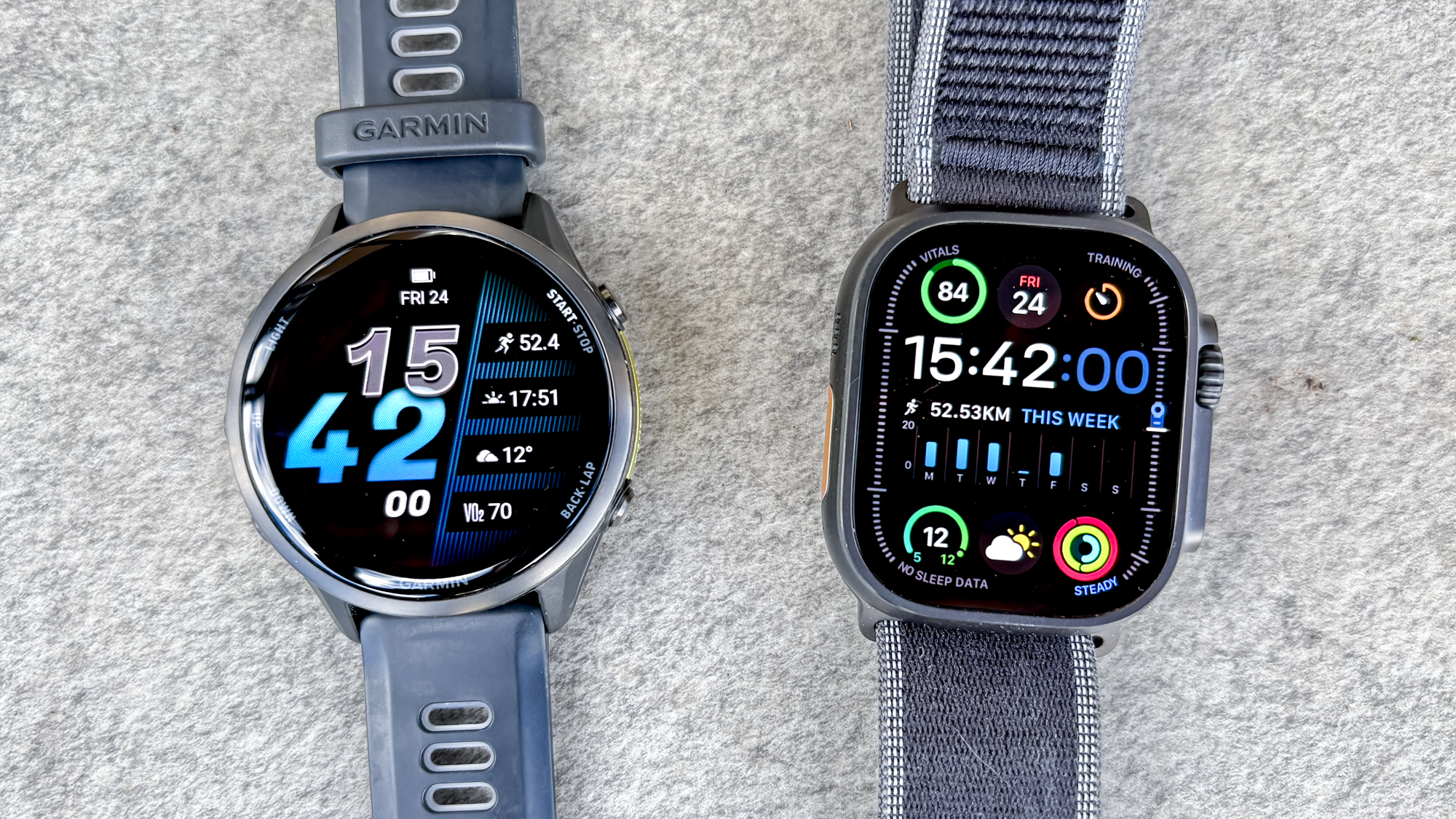iPhone 6s Plus vs. Galaxy Note 5: Ultimate Phablet Battle
The big-screen phones from Apple and Samsung go head to head in eight rounds of battle.
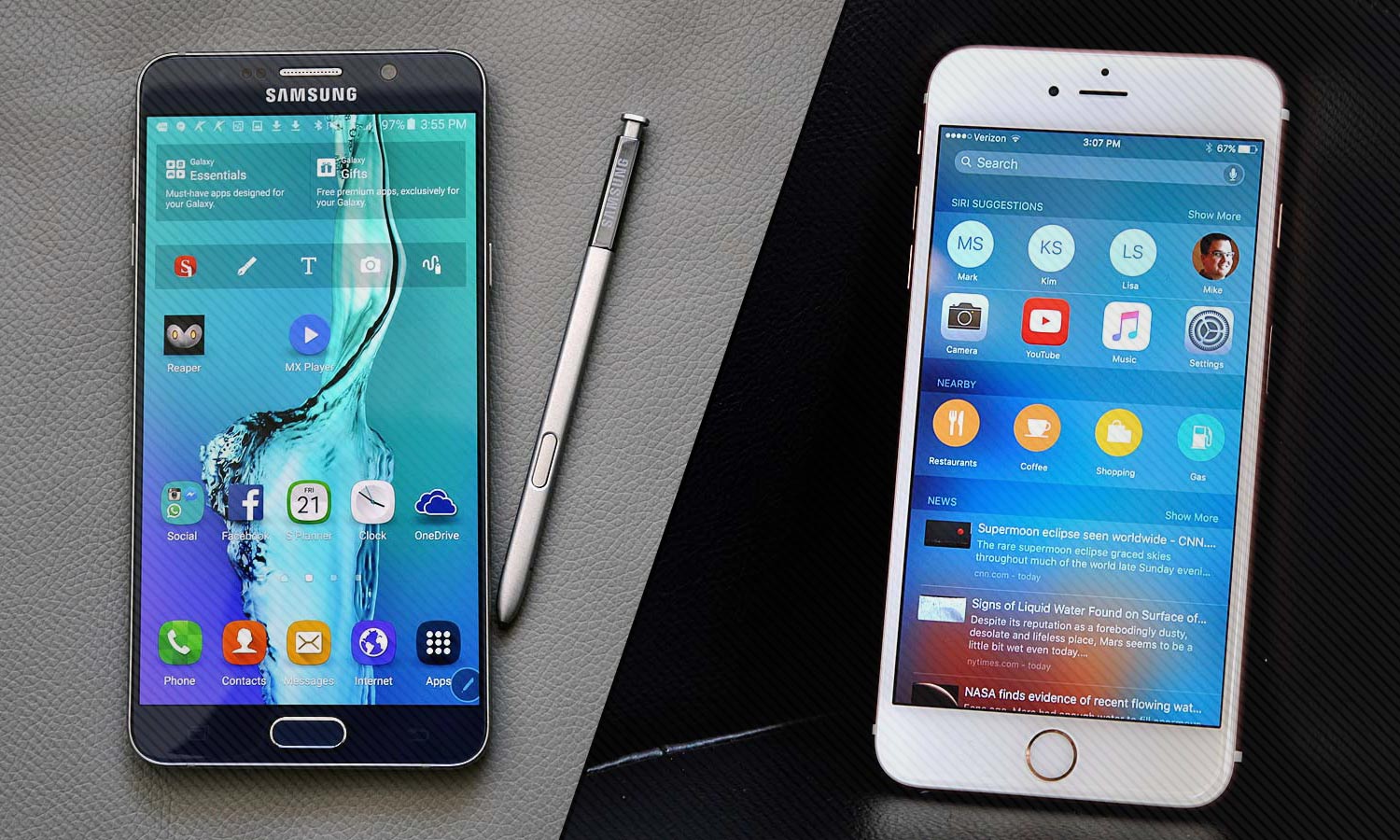

Flagship phones don't get more primo than the iPhone 6s Plus or Galaxy Note 5. Packing a fast new A9 processor and improved cameras, the latest big-screen iPhone ($749) is ready to take on the Android-powered, pen-equipped Galaxy ($699). The Note 5 lets you take notes when the screen is off and sports a sleek, glass-and-metal redesign, but the iPhone 6s Plus offers a new 3D Touch display and Live Photos feature.
To help you decide which phone to buy, we put both devices through eight rounds of competition and declared a winner.
Design (10 Points)
While not quite as fetching as the Galaxy S6 Edge Plus and its dual-curve display, the Note 5 is a striking smartphone in its own right. The rounded glass edges on the back look elegant and provide a sure grip, while the aluminum frame adds both stability and nice contrast.

Measuring 6 x 2.9 x 0.29 inches and weighing 6 ounces, the Note 5 is shorter, narrower and lighter than the iPhone 6s Plus (6.2 x 3.1 x 0.29 inches and 6.8 ounces). In other words, it's easier to use in one hand.

It's not like the iPhone 6s Plus is unattractive. It has a stronger cover-glass than last year's Plus, and the rounded edges look sleek (though they feel slippery). There's also a new Rose Gold color. However, the two lines running across the back almost spoil the aesthetic.
Winner: Galaxy Note 5. The Galaxy Note 5 looks better and feels better.
Display (10 Points)
On paper, Samsung has this round locked up. The Note 5's Super AMOLED display is bigger and sharper than the iPhone 6s Plus' LCD, with the Note 5 measuring 5.7 inches and 2560 x 1440 pixels, versus 5.5 inches and 1920 x 1080 pixels for Apple's phone.
Get instant access to breaking news, the hottest reviews, great deals and helpful tips.
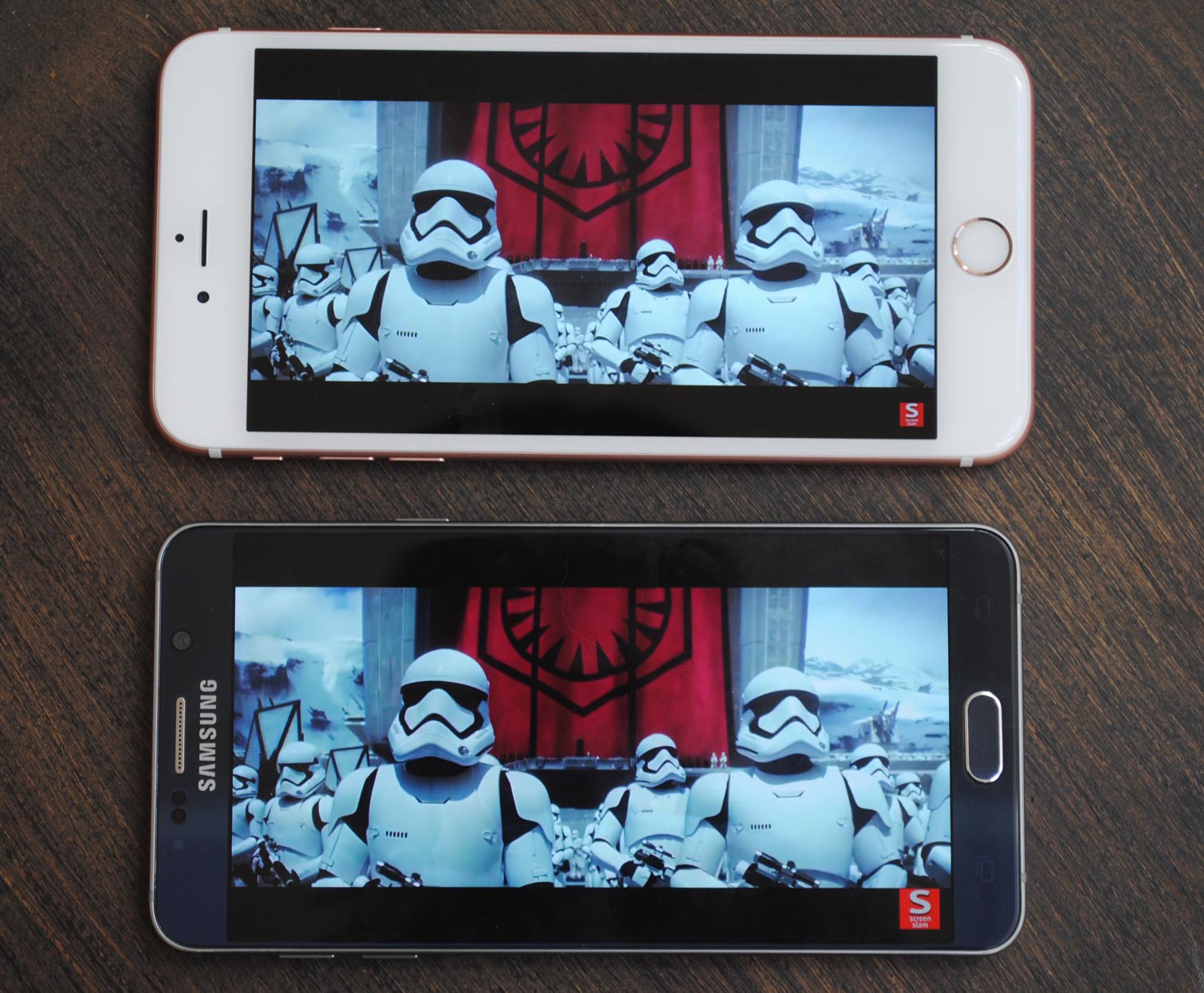
The Note 5 shines a bit brighter, too, notching 510 nits on our meter, compared to the iPhone's 498 nits.
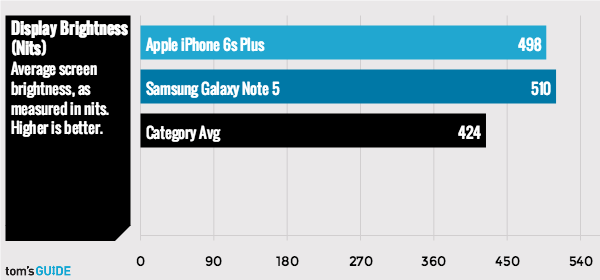
The Super AMOLED panel on the Samsung offers richer hues, even if some colors look oversaturated. The Note 5 reproduced 193 percent of the sRGB color gamut, versus 105.1 percent for the iPhone 6s Plus. However, the iPhone offers more-accurate colors, as its Delta-E rating of 0.4 (0 is best) soundly beats the Samsung's mark of 2.7.
Winner: Galaxy Note 5. It really comes down to personal preference — more-saturated vs. more-accurate colors — but the Note 5's higher resolution and bigger size give it the edge.
Audio (5 Points)
Both the iPhone 6s Plus and Note 5 sport bottom-mounted speakers, but the Samsung phone wins on volume. When I streamed Bruno Mars' "Just the Way You Are," the Note 5 filled my kitchen with sound. However, while the iPhone 6s wasn't as powerful, its speaker produced richer audio, doing a better job balancing the soaring vocals with the beat. The Note 5 sounded a bit harsh in comparison.
MORE: Best Smartphones on the Market Now
With Samsung Level headphones plugged in, the Note 5 is supposed to have an advantage with its UHQ Upscaler setting enabled, but I didn't notice much of a difference.
Winner: iPhone 6s Plus. Louder doesn't mean better.
Special Features (15 Points)
The iPhone 6s Plus fights back in this round with two uniquely compelling special features: 3D Touch and Live Photos. The 3D Touch display on the iPhone allows you to press on all sorts of things to perform shortcuts, while providing haptic feedback. For example, pressing on a Web link in an email will let you preview the page in Safari without leaving the email app. And from the home screen, you can press on an app icon to reveal various Quick Actions. Developers are getting in on the act, too, adding 3D Touch to their apps.
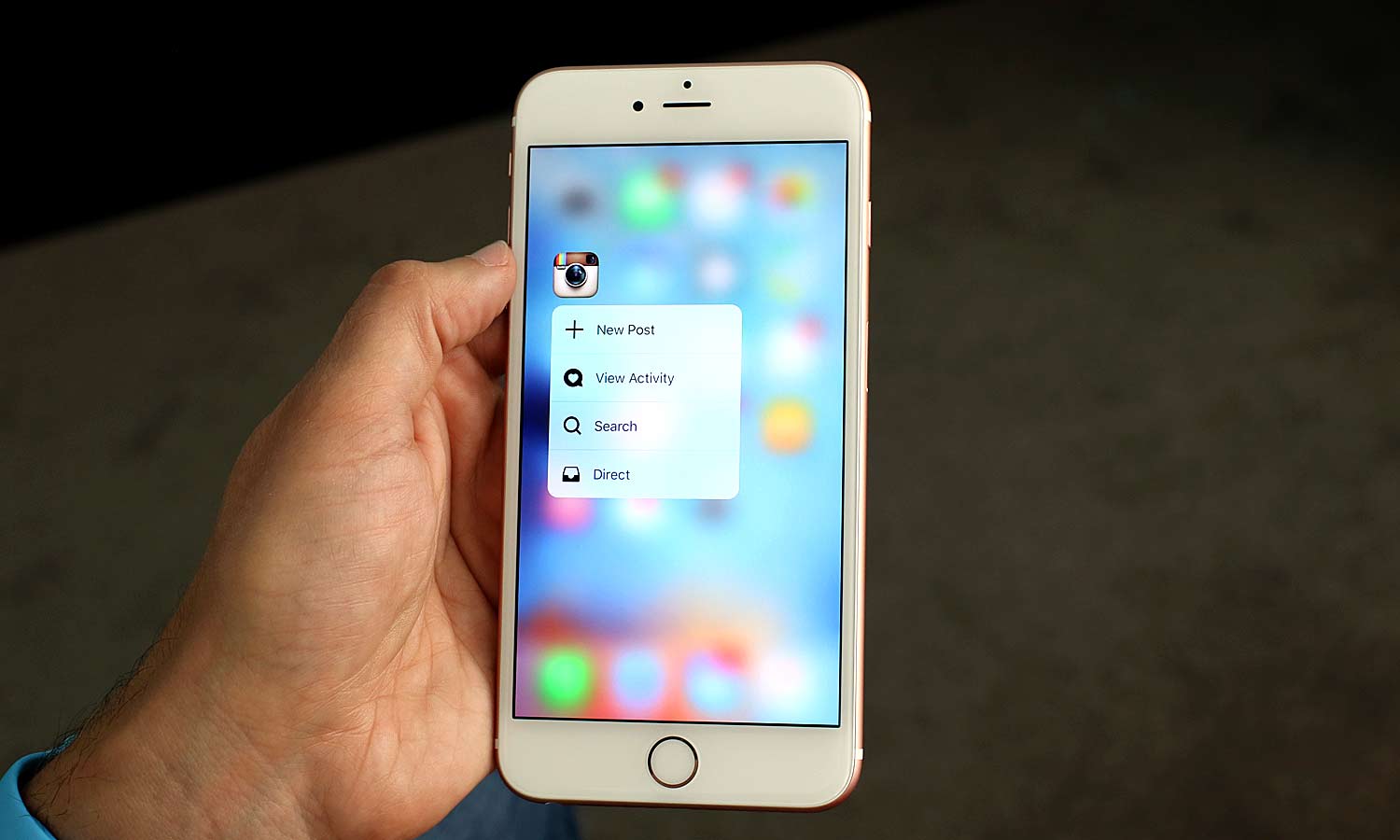
The Live Photos feature brings still images to life by automatically recording 1.5 seconds of video before and after you click the shutter. A live photo of a fountain is a great example, as was a portrait of my son making various funny faces.
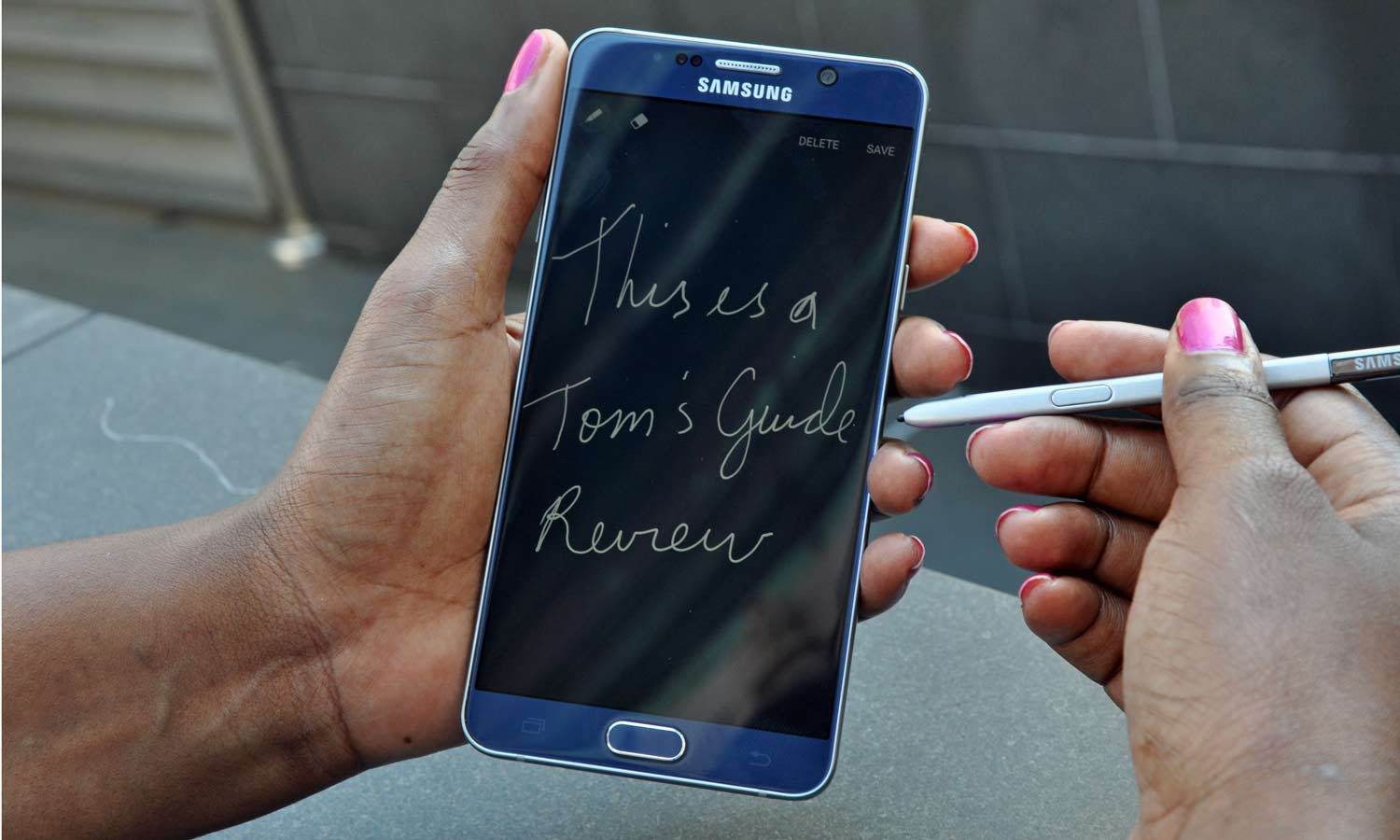
The Note 5's biggest weapon is its S Pen, which gains new capabilities with this device. For the first time, you can scribble notes right after you eject the pen, without turning the screen on. You can also now sign PDFs and capture entire screens for markups by scrolling with the pen.
Samsung's phablet continues to have an advantage over the iPhone by allowing you to run two apps side by side via the Note 5's Multi Window feature. It's a great way to make the most of the large canvas. Plus, only the Note 5 gives you both wireless charging and quick wireless charging.
Both the iPhone 6s Plus and Galaxy Note 5 support mobile payments via Apple Pay and Samsung Pay, respectively. However, the latter phablet's support for magnetic swipe terminals means you should be able to use it more places.
Winner: Galaxy Note 5. 3D Touch on the iPhone is truly innovative, but Samsung has more weapons in its features arsenal.
Performance (20 Points)
The iPhone 6s Plus (powered by an A9 processor and 2GB of RAM) and the Galaxy Note 5 (octa-core Exynos 7420 CPU with 4GB of RAM) are two of the fastest phones on Earth, but one handset has to reign supreme.
On our first real-world performance test, we timed how long it took each phone to open a huge PDF (1.6GB). We measured how long it took to open the PDF (using Adobe Reader on Android and iOS), using a camera capable of recording slow-motion video at 240 fps to time the process. The iPhone 6s Plus took a much quicker 375 milliseconds, compared to 626 ms for the Galaxy Note 5.
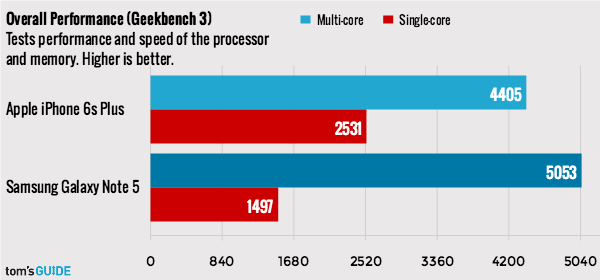
Next, we timed how long it took to open the camera on each device with 10 apps running in the background. Once again, the iPhone came out on top, with a time of 66.3 ms versus 94.8 ms for the Galaxy Note 5.
We also timed how long it took each phone to open the Sonic 2 racing game, and it was a close finish. The iPhone 6s Plus took 10.45 seconds, compared to 11.91 seconds for the Note 5.
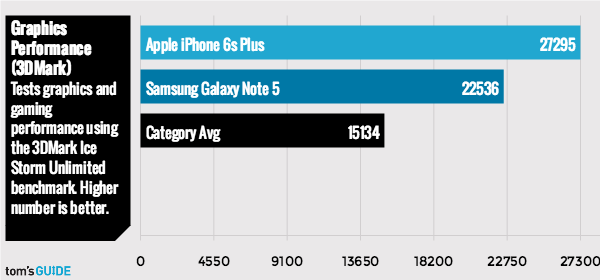
The Note 5 did beat the iPhone on the multicore portion of the Geekbench 3 synthetic benchmark, which measures overall performance. The Samsung notched a score of 5,088 to 4,405 for the Apple device, but the iPhone pulled ahead on the single-core portion of the test (2,531 versus 1,497).
Last but not least, we used the 3DMark IceStorm Extreme test to measure the graphics performance of these phablets. The iPhone 6s registered a higher 27,295 to the Note 5's 24,212.
Winner: iPhone 6s Plus. The iPhone offered faster performance across a wide range of tests.
Cameras (20 Points)
When we reviewed the Note 5, we said its 16-megapixel camera was one of the best around, but it has since been surpassed by the iPhone 6s Plus in terms of image quality. In side-by-side photos we took with each device, the iPhone delivered better results overall.
Apple's phone took a much more pleasing cityscape shot, with a bluer sky and warmer-looking buildings, even though there was more of a yellowish tinge to the shot.
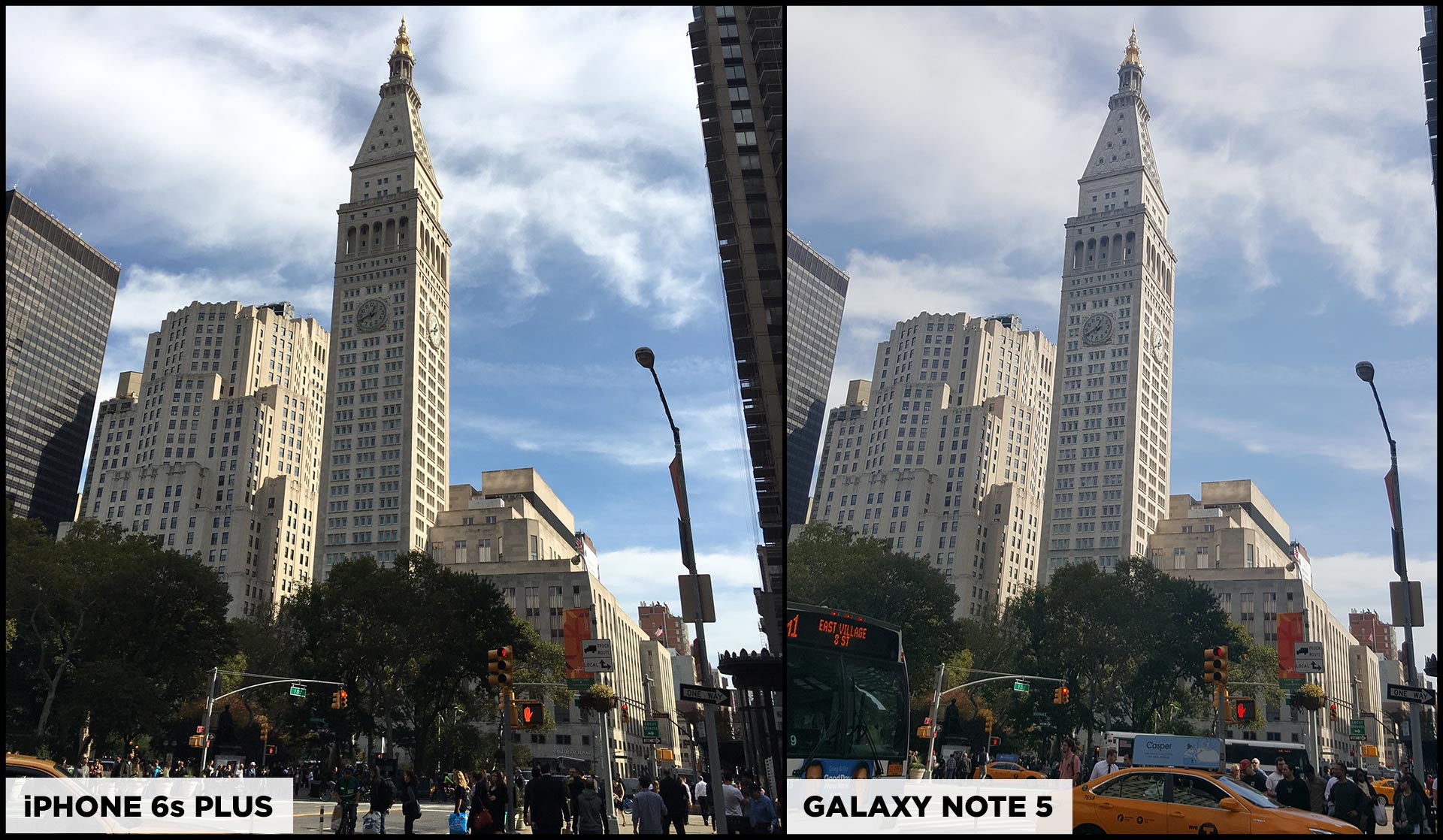
Indoors at a concert, the iPhone 6s captured a darker but ultimately clearer portrait, and it better dealt with a couple of lights near the floor. The Galaxy Note 5's image looked a little blown out.
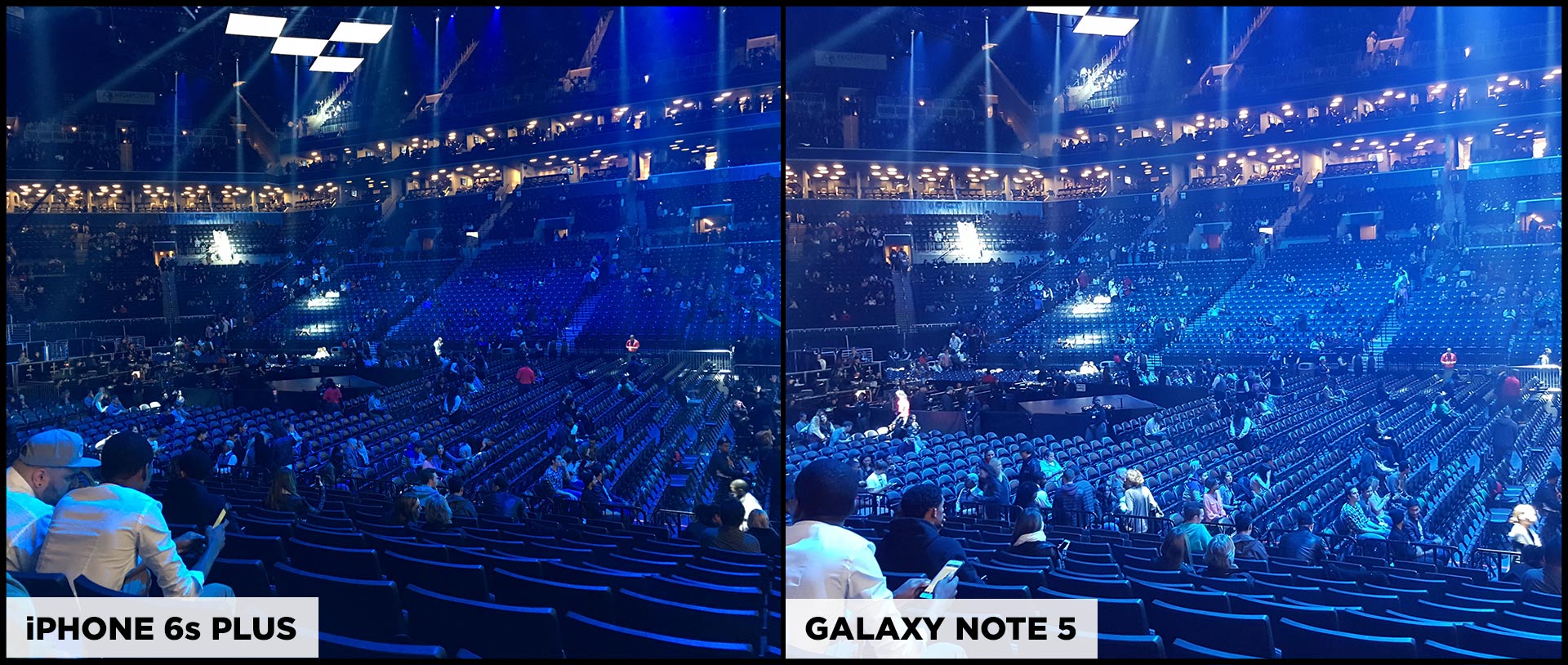
We saw similar results with the front cameras on these phones. The iPhone's 5-MP selfie shooter delivered more-natural-looking skin tones and made our subject's blue dress really pop. The Samsung image looked downright hazy under the same conditions.
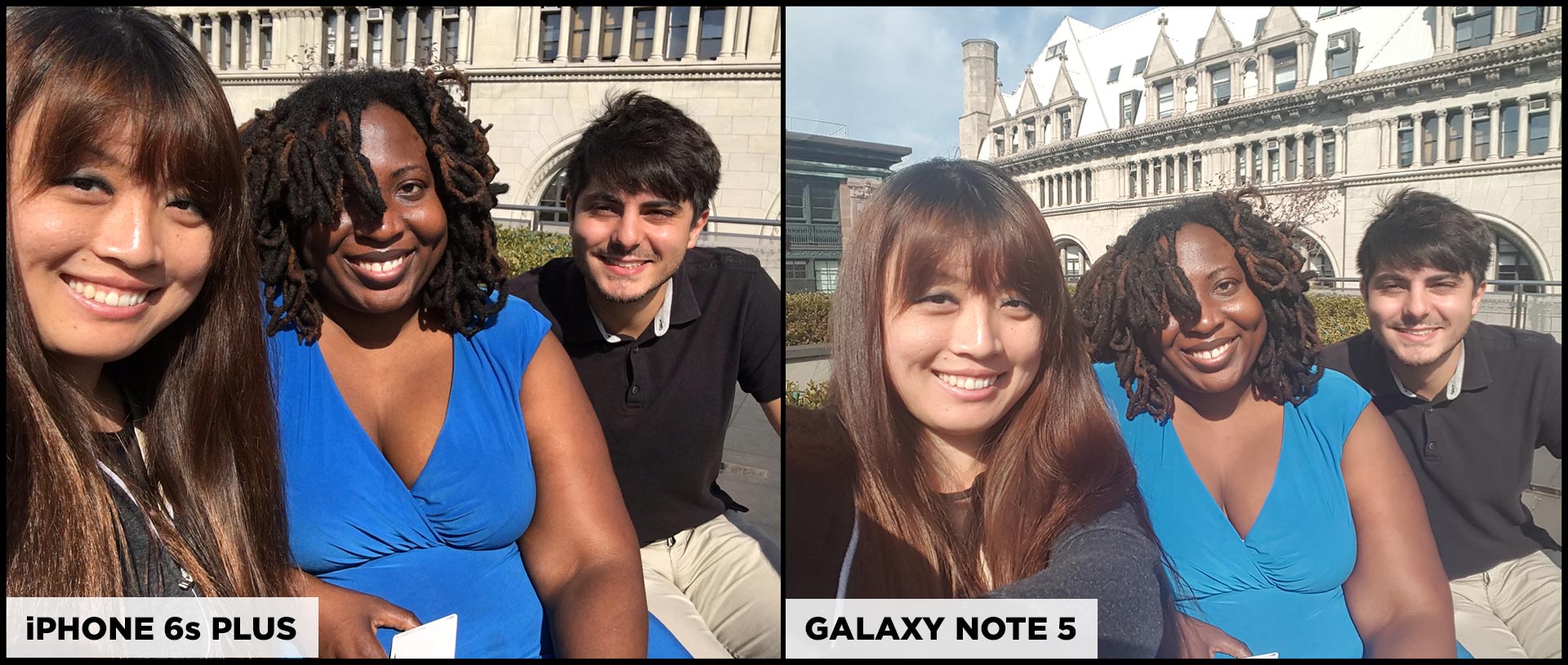
Winner: iPhone 6s Plus. Apple's phablet simply takes better-looking photos.
Battery Life (15 Points)
The Galaxy Note 5 packs a 3,000-mAh battery and lasted a fairly impressive 7 hours and 58 minutes on our battery test, which involves continuous Web surfing over 4G LTE at 150 nits of screen brightness. This was on Verizon's network. On the same network, the iPhone 6s Plus (with a rated 2,750-mAh battery, based on teardowns) lasted a slightly longer 8 hours and 16 minutes.
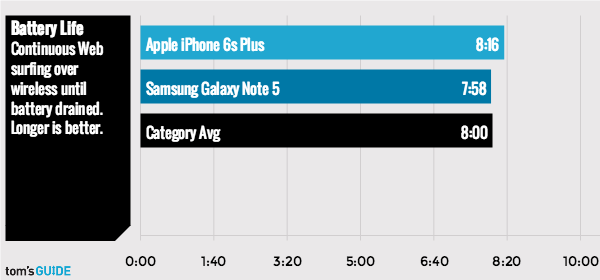
It's worth noting that only the Galaxy Note 5 offers both wireless charging and a quick charger that will get you back up and running fast.
Winner: iPhone 6s Plus. It offers slightly longer endurance.
Value (10 Points)
The iPhone 6s Plus and Note 5 are both among the most expensive phones available, but the Note 5 gives you more for its base price of $699 (about $29 per month on Verizon). Samsung includes 32GB of storage standard, compared to just 16GB for the $749 iPhone ($31.24 per month). You would need to spend an extra $100 to get 64GB on the Apple. There's also a 64GB version of the Galaxy Note 5, which is $100 more than the 32GB version of the device.
Winner: Galaxy Note 5. Lower starting price, more storage.
Overall Winner: iPhone 6s Plus
It's hard to pick a winner when you're comparing two of the best phones of the year. The Android-powered Galaxy Note 5 takes some important rounds in this contest, including design, display, value and special features. Despite packing a bigger screen, the Note 5 is easier to use with one hand, because it's more compact. And if you like the idea of using a pen with your phone, this is certainly the phablet to get.
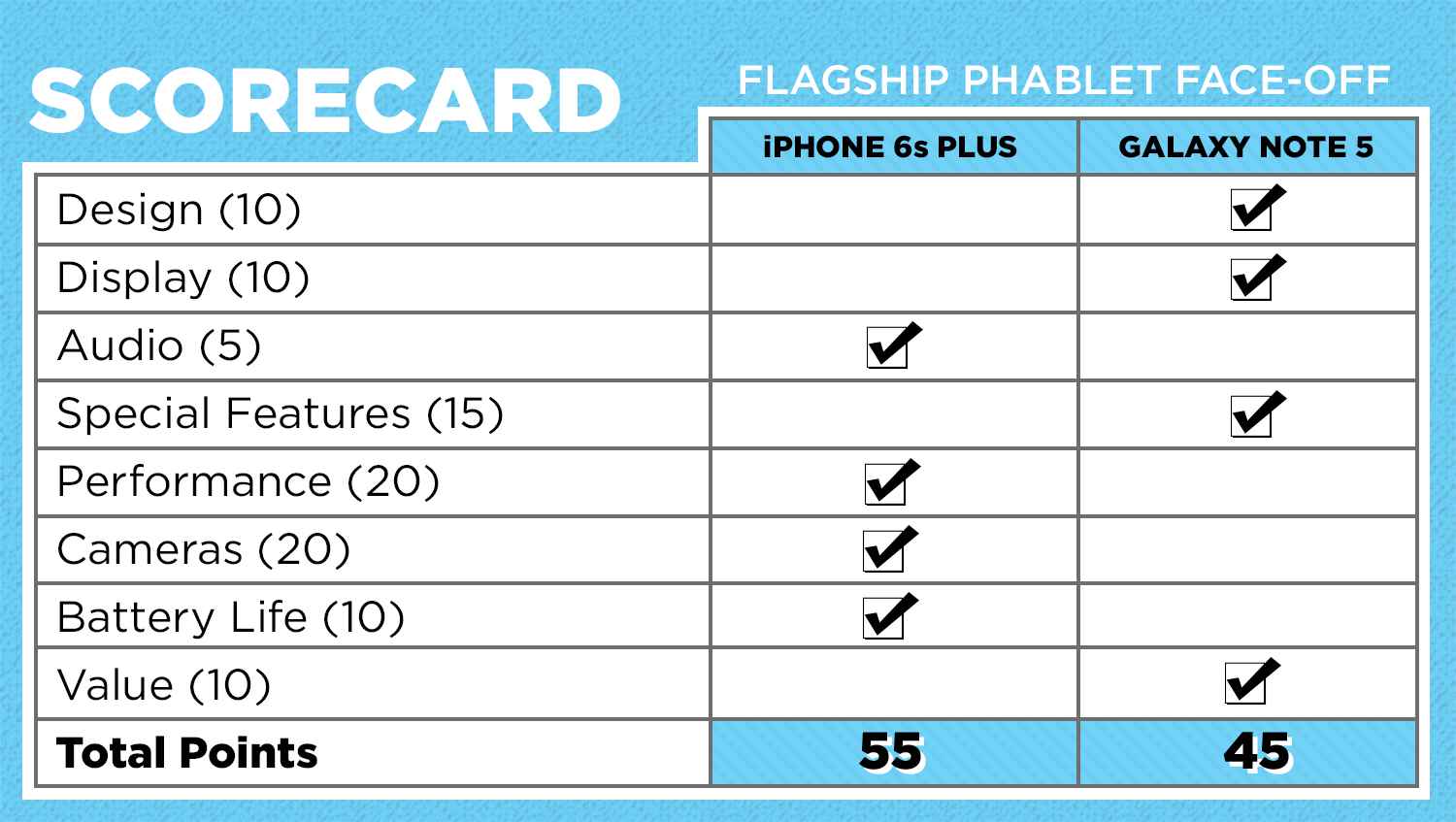
The iPhone 6s comes out (barely) on top because it is significantly faster (both in real-world scenarios and synthetic benchmarks), and because it simply takes better pictures based on our side-by-side comparisons. The iPhone 6s is no slouch in the features department, either, as its 3D Touch adds a level of immersion to the overall user experience while saving you time.
Both of these phones are well worth the premium, but the iPhone 6s Plus emerges as the victor.
Mark Spoonauer is the global editor in chief of Tom's Guide and has covered technology for over 20 years. In addition to overseeing the direction of Tom's Guide, Mark specializes in covering all things mobile, having reviewed dozens of smartphones and other gadgets. He has spoken at key industry events and appears regularly on TV to discuss the latest trends, including Cheddar, Fox Business and other outlets. Mark was previously editor in chief of Laptop Mag, and his work has appeared in Wired, Popular Science and Inc. Follow him on Twitter at @mspoonauer.
-
gprice Didn't the Note 5 win the "Audio" portion? Then in the check box it says iPhone won. This would sway the whole thing to the Note 5.Reply -
James_234 Well it's Says the iPhone won the audio test if you read the article. Also even if the note won the audio it would then just he a tie 5o/50Reply

